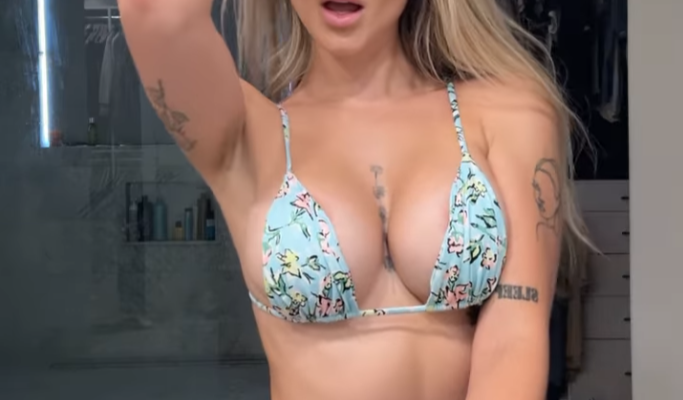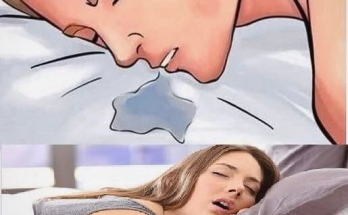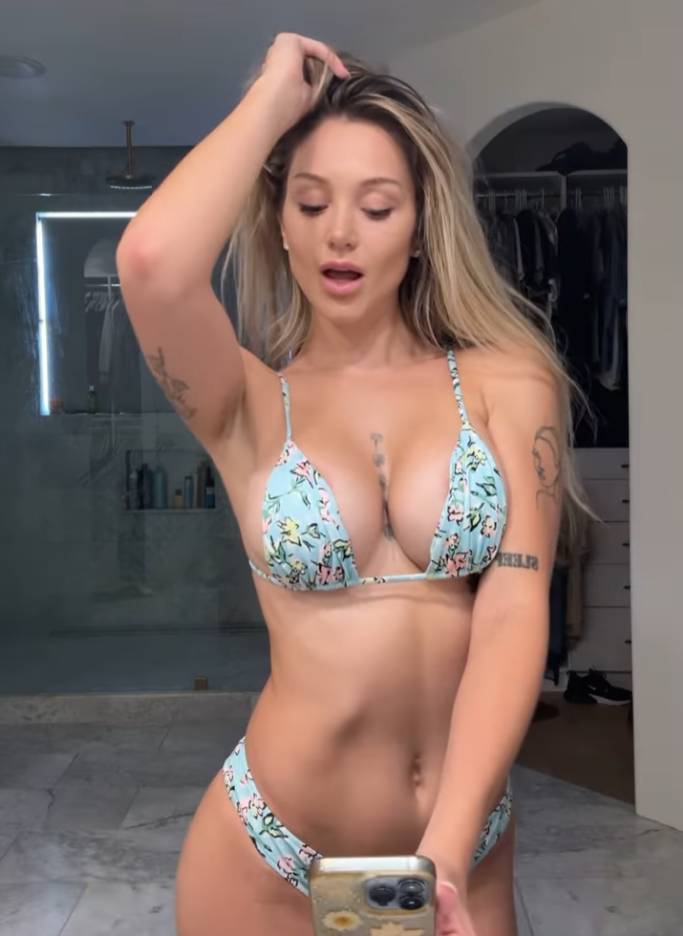
let’s go deeper than the mirror’s surface and explore the layers this photo evokes, both visually and symbolically. What we see at first glance is someone capturing themselves in a moment of casual intimacy: a mirror selfie in a bathroom, wearing a light blue bikini adorned with a floral print, surrounded by the silent witnesses of everyday life—a closet ajar, clothes gently hanging, bottles quietly lined up behind glass.
💠 Visual Composition and Mood
- Framing & Environment: The setting is domestic yet curated—a bathroom with clean lines, enclosed shower glass, and a visible closet in the background. The environment feels lived-in but not chaotic. It’s tidy without being sterile, which adds emotional realism. The reflection becomes a deliberate act of self-presence, an assertion of “I exist here”—not just in physical space, but in the memory being created.
- Color and Pattern: The light blue bikini plays harmoniously with the overall palette of the room. The floral patterns add softness, suggesting a balance between strength and playfulness. These patterns seem to echo the floral phone case—a subtle nod to consistency in personal taste, and possibly a gentle assertion of self-expression.
- Textures and Light: The gleam of glass in the shower enclosure contrasts with the matte softness of skin and fabric. There’s something tactile about the scene: the crisp feel of the swimsuit, the coolness of tiles, the faint warmth of soft lighting bathing the person evenly. The lighting doesn’t dramatize—it reveals.
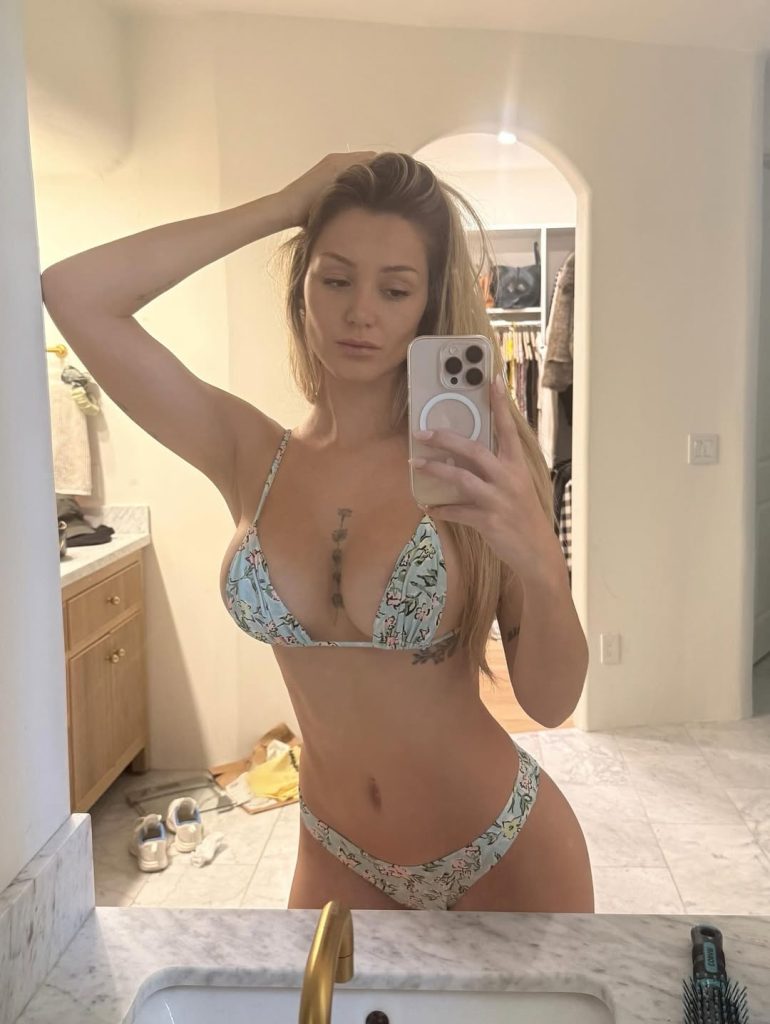
🌺 Body, Ink, and the Act of Self-Capture
- Posture & Expression: The individual stands confidently, phone raised to frame the shot. The mirror selfie transforms the viewer’s gaze into something collaborative—inviting but not pleading. There’s poise in the stance. The photo doesn’t demand attention; it holds it naturally.
- Tattoos as Narrative: The inked skin, especially the tattoos on the left arm and chest, serves as a visible archive—a visual journal etched into the body. Tattoos often carry stories, wounds, or triumphs, and here they balance the femininity of the floral bikini with something more grounded and assertive. They suggest resilience. Multiplicity. Identity layered with complexity.
- The Mirror as Medium: Mirrors are more than tools for reflection—they’re instruments of truth, distortion, and transformation. Capturing oneself in a mirror is inherently dual: it offers control (you choose what to show) but also transparency (you see your surroundings as others might). It becomes performative, but not necessarily artificial.
🧠 Symbolism and Emotional Resonance
- Intimacy vs Exposure: The act of photographing oneself in a vulnerable space—a bathroom—is quietly powerful. Bathrooms are where we face our reflections most honestly: washed of pretense, clothed in the raw reality of being. To then turn that space into a moment of self-expression shifts the narrative from passive routine to active authorship.
- Floral Imagery & Femininity: The repetition of florals—the bikini and the phone case—brings a motif of growth and softness. Flowers bloom in unlikely places, much like confidence. The choice may suggest an embrace of self-love, or even a playful rebellion against rigid ideals of beauty.
- Closet in the Background: Clothes hanging in an open closet carry layered meaning. They speak to daily life, continuity, but also to potential transformation. What we wear shapes how we feel. The openness of the closet—everything on display—parallels the openness of the image: there’s no attempt to hide. This is not curated perfection; it’s authenticity presented with quiet dignity.
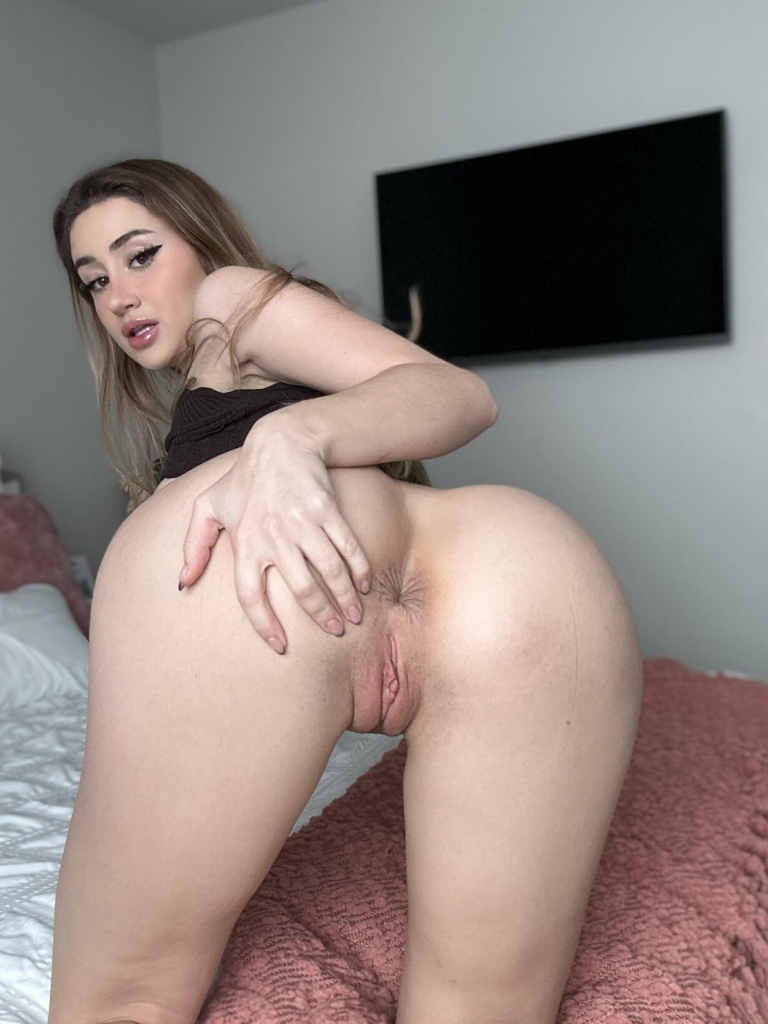
🔍 Thematic Underpinnings
- Control and Vulnerability: This image rides the line between curated and candid. The person chooses how to be seen, yet they remain entirely grounded in real space. That balance echoes broader themes of personal agency: being both the observer and the subject, the lens and the gaze.
- Identity as Performance: All mirror selfies are inherently performative, yet they offer moments of real connection when they shed the need to impress. Here, the performance feels genuine—a stylized version of reality, yes, but not disconnected from it. It’s an intimate offering, not a spectacle.
- Sensory and Spatial Layers: The image invites tactile imagining. You can almost feel the glass shower door, hear the click of the phone camera, sense the breeze from an open bathroom window. There’s a spatial rhythm to the scene—everything in its place, yet nothing overly staged.
✨ Interpretive Reframing: A Moment Claimed
What makes this photo resonate isn’t just how it looks—it’s the emotional undertow. The person taking the photo doesn’t seem to be asking for permission to exist in this space. They simply claim it. Not with grand gestures, but through the quiet insistence of visibility.
It’s a study in contrast:
- Strength and softness.
- Exposure and control.
- Delicacy of florals against the permanence of ink.
It’s not just a selfie—it’s a declaration. A bloom in an ordinary mirror. A body speaking its story not in loud words, but through composition, presence, and choice.
Would you like me to reframe this description through a different lens—maybe something more poetic, abstract, or emotionally immersive?
